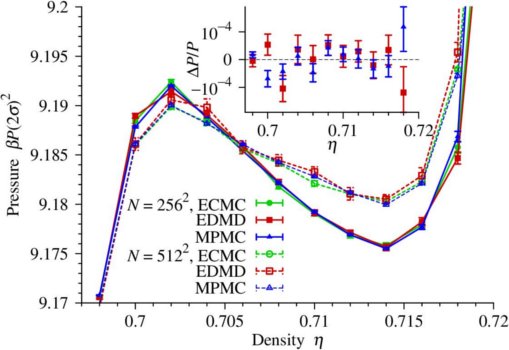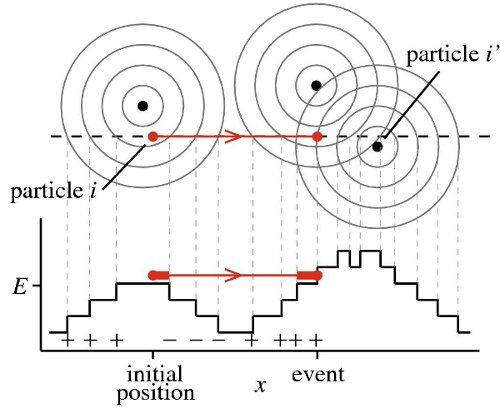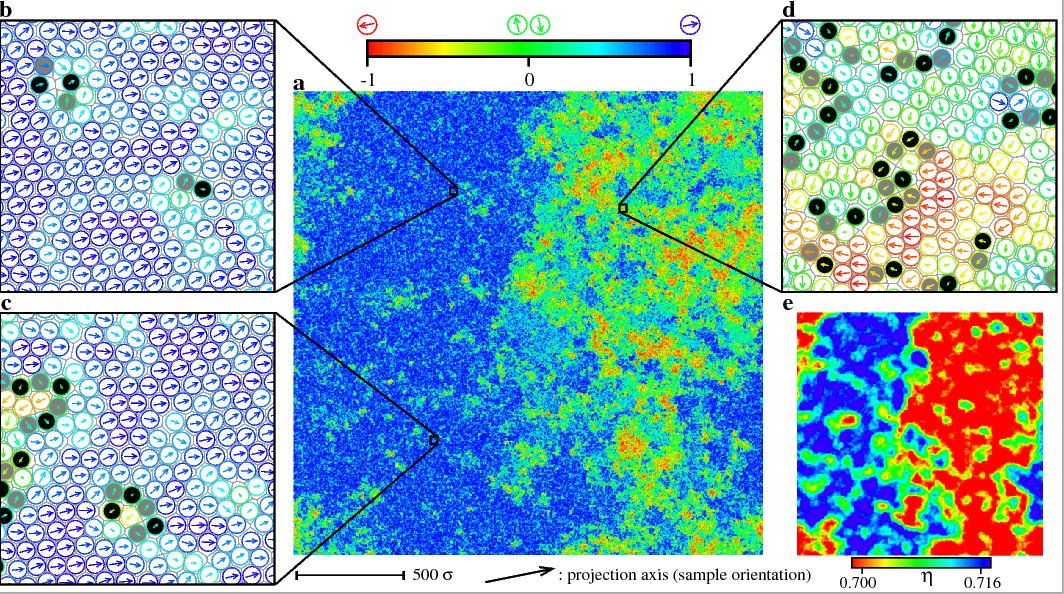Main Page
From Werner KRAUTH
| Revision as of 22:48, 6 November 2012 Werner (Talk | contribs) (→Upcoming events) ← Previous diff |
Revision as of 13:08, 11 November 2012 Werner (Talk | contribs) Next diff → |
||
| Line 25: | Line 25: | ||
| [[Image:Hard disk melting.jpg|left|100px|border|thumb|Melting of hard disks]]By the way: the term '''melting of hard disks''' does not relate to the irreversible memory loss when your laptop catches fire (left figure), but to a fundamental phase transition in the model of two-dimensional hard spheres, that is, billiard balls without friction and without inner structure (center and right figures). The possibility that two-dimensional systems with continuous degrees of freedom could melt was discovered in 1962, by Alder and Wainwright, but the nature of the transition remained a mystery for several decades ([[Bernard_Krauth_2011|but we think we now solved it]]). | [[Image:Hard disk melting.jpg|left|100px|border|thumb|Melting of hard disks]]By the way: the term '''melting of hard disks''' does not relate to the irreversible memory loss when your laptop catches fire (left figure), but to a fundamental phase transition in the model of two-dimensional hard spheres, that is, billiard balls without friction and without inner structure (center and right figures). The possibility that two-dimensional systems with continuous degrees of freedom could melt was discovered in 1962, by Alder and Wainwright, but the nature of the transition remained a mystery for several decades ([[Bernard_Krauth_2011|but we think we now solved it]]). | ||
| + | <br clear="all" /> | ||
| + | |||
| + | ==Hard-disk equation of state: First-order liquid-hexatic transition in two dimensions with three simulation methods== | ||
| + | |||
| + | |||
| + | [[Image:Eqofstate.jpg|left|200px|border|thumb|Move of one particle in the Event-driven MC algorithm]] Spring and summer of 2012 was partly spent on a project with colleagues Joshua Anderson, Michael Engel and Sharon Glotzer from the University of Michigan, Masaharu Isobe form the Nagoya Institute of Technology, and Etienne Bernard from MIT. We were interested in checking [[Bernard_Krauth_2011|our earlier results]] on the melting transition of hard disks in two dimensions which predicted the existence of a first-order liquid-hexatic phase transition - a big surprise after hundreds of other papers had fought over two other scenarios for melting in two dimensions. [[Anderson et al 2012| Our confirmation preprint]] finally came out in November 2012. Using three completely independent algorithms ([http://arxiv.org/abs/1211.1646v1 massively parallel local Monte Carlo], molecular dynamics, [[Bernard_Krauth_Wilson_2009|event-chain Monte Carlo]]), we confirmed our earlier data (see figure to the left). We are all happy about this independent verification, and Etienne Bernard and I are quite relieved, as so much can go wrong with numerical simulations, especially if they take an eternity, almost, to run. | ||
| + | |||
| + | The figure to the left shows the equation of state for hard disks (the equilibrium pressure as a function of the density (or the volume), with the characteristic loop which indicates the presence of two phases - a minority phase that forms a bubble inside the majority phase. The inset gives the difference between the old data (from last year) and the new ones. Let me note that, if the simulation is nontrivial, the calculation of the pressure is quite tricky also. Those of us who did Monte Carlo evaluation were much relieved to see the nice agreement with the molecular dynamics results, obtained with Masaharu Isobe's code. | ||
| + | |||
| <br clear="all" /> | <br clear="all" /> | ||
Revision as of 13:08, 11 November 2012
Werner Krauth Laboratoire de Physique Statistique École normale supérieure 24 rue Lhomond 75231 Paris Cedex 05 France Tel +33 (0)1 44 32 25 50 werner.krauth@ens.fr
CNRS Research Director (Theoretical Physics)
Director of the Physics Departement at Ecole normale supérieure, Paris, France (since January 2010);
Director of the LabEx ENS-ICFP ( ENS-International Center for fundamental physics and its interfaces).
Contents |
Current research
I am deeply interested in statistical physics and condensed matter physics, often in connection to computation and algorithms. Current interests are in hard spheres, mainly the melting transition in two-dimensional disks, bosons (in collaboration with the experimental groups at ENS), and the theory of convergence and of coupling in Markov chains.
By the way: the term melting of hard disks does not relate to the irreversible memory loss when your laptop catches fire (left figure), but to a fundamental phase transition in the model of two-dimensional hard spheres, that is, billiard balls without friction and without inner structure (center and right figures). The possibility that two-dimensional systems with continuous degrees of freedom could melt was discovered in 1962, by Alder and Wainwright, but the nature of the transition remained a mystery for several decades (but we think we now solved it).
Hard-disk equation of state: First-order liquid-hexatic transition in two dimensions with three simulation methods
Spring and summer of 2012 was partly spent on a project with colleagues Joshua Anderson, Michael Engel and Sharon Glotzer from the University of Michigan, Masaharu Isobe form the Nagoya Institute of Technology, and Etienne Bernard from MIT. We were interested in checking our earlier results on the melting transition of hard disks in two dimensions which predicted the existence of a first-order liquid-hexatic phase transition - a big surprise after hundreds of other papers had fought over two other scenarios for melting in two dimensions. Our confirmation preprint finally came out in November 2012. Using three completely independent algorithms (massively parallel local Monte Carlo, molecular dynamics, event-chain Monte Carlo), we confirmed our earlier data (see figure to the left). We are all happy about this independent verification, and Etienne Bernard and I are quite relieved, as so much can go wrong with numerical simulations, especially if they take an eternity, almost, to run.The figure to the left shows the equation of state for hard disks (the equilibrium pressure as a function of the density (or the volume), with the characteristic loop which indicates the presence of two phases - a minority phase that forms a bubble inside the majority phase. The inset gives the difference between the old data (from last year) and the new ones. Let me note that, if the simulation is nontrivial, the calculation of the pressure is quite tricky also. Those of us who did Monte Carlo evaluation were much relieved to see the nice agreement with the molecular dynamics results, obtained with Masaharu Isobe's code.
Event-driven Monte Carlo algorithm for general potentials
In recent works, as for example on the melting transition in two dimensions, the event-chain algorithm has proven quite helpful. This hard-sphere Monte Carlo method runs a lot faster than earlier methods although the speed-uo remains constant for large system sizes. Nevertheless, gaining a factor of about 100 is not so bad for run-times (with the new algorithm) on the order of a few months... we got our results before it was time to retire.
Recently, Etienne Bernard (now at MIT) and I were able to extend the event-chain algorithm to continuous potentials, and we are now quite excited: The algorithm allows to break detailed balance, it is (hopefully) much faster than local Monte Carlo algorithms, and it is extremely easy to program, to parallelize (hopefully), to modify and, why not, to improve. Technically, we work with stepped potentials (see the figure, similar approaches exist for molecular dynamics), but there is no problem going to finer and finer discretizations: the algorithm doesn't even slow down as we crank up the number of steps. This is explained in a section of the wiki page dedicated to our recent paper. But lots of things need to be done to understand this new approach, to check out possible applications, etc, and we are right now extremely busy.
Two-dimensional melting: First-order liquid-hexatic transition
Here, I show the key figure of a recent paper, with Etienne Bernard, on the melting transition in hard disks. The main picture shows the orientations of a configuration with 1024x1024 disks, and two different regions are clearly visible: To the left, disks have more or less the same orientation, whereas to the right, the orientations vary (and the local densities are lower). To produce the picture, we used theevent-chain algorithm, a new Monte Carlo method that we developed a few years ago, with David Wilson. This algorithm is really the first one to outperform the classic Metropolis method from 1953. For a long time, I have been interested in the hard-disk melting problem, but an earlier attempt to speed up the extremely slow converge of numerical methods for this problem, the cluster algorithm that I developed with C. Dress, had failed.
Upcoming events
Berkeley Mini Stat Mech Meeting 11 - 13 January 2013, Berkeley, CA, USA (Invited talk)
Statphys25, July 22 – 26, 2013, Seoul National University, Seoul, Korea (Invited talk)
Here is the schedule of past events
Text book

A picture book of algorithms










